Storage Stability Testing in Harvested Crops
In agriculture and forestry testing, ensuring the quality of harvested crops is paramount. Post-harvest quality testing plays a critical role in maintaining crop integrity throughout storage and transport stages. One essential aspect of this process is Storage Stability Testing (SST), which evaluates how well harvested crops maintain their quality during prolonged storage periods.
Storage stability directly impacts the economic viability of agricultural operations by influencing marketability, shelf life, and overall consumer satisfaction. This test assesses factors such as moisture content, temperature sensitivity, oxygen levels, and microbial activity that can degrade crop quality over time. For instance, improper storage conditions for grains like wheat or corn can lead to spoilage, reduced yield, and increased mold growth.
For perishable crops such as fruits and vegetables, SST helps determine optimal storage temperatures and humidity levels needed to preserve freshness and texture. Understanding these parameters is crucial not only for minimizing waste but also for enhancing shelf life during distribution networks. By leveraging accurate testing methods early in the supply chain, producers can make informed decisions about handling practices that extend product longevity.
Furthermore, SST provides valuable insights into potential challenges faced by growers and processors regarding long-term storage capabilities. This knowledge enables them to implement necessary adjustments or improvements before issues arise. For example, if a specific variety of apple exhibits rapid deterioration under certain storage conditions, this information can guide future research efforts aimed at developing more resilient cultivars.
The importance of SST extends beyond just maintaining physical attributes; it also ensures compliance with regulatory standards set by organizations like the Food and Agriculture Organization (FAO) or individual country-specific guidelines. Adhering to these regulations helps protect public health while fostering sustainable agricultural practices.
Applied Standards
| Standard Name | Description |
|---|---|
| ISO 17025:2017 | International standard for the general requirements for the competence of testing and calibration laboratories. |
| ASTM D6983-14 | American Society for Testing Materials standard practice for evaluating storage stability of agricultural products using accelerated aging tests. |
Scope and Methodology
The scope of Storage Stability Testing encompasses various aspects related to the preservation of harvested crops during storage. It includes evaluating factors such as moisture content, temperature fluctuations, oxygen levels, microbial activity, and chemical composition changes over extended periods.
| Methodology | Description |
|---|---|
| Sample Preparation | Properly selected and prepared samples are critical for accurate testing results. Samples should be representative of the entire batch or lot being tested. |
| Environmental Control | Controlled environmental chambers simulate real-world storage conditions to observe how changes in temperature, humidity, and other variables affect crop quality. |
Benefits
- Enhanced Crop Quality: Ensures that harvested crops remain at optimal quality throughout storage, leading to better marketability and higher prices.
- Cost Efficiency: By identifying potential issues early in the supply chain, businesses can avoid costly post-harvest losses and unnecessary waste.
- Regulatory Compliance: Adhering to relevant standards helps ensure that products meet all necessary regulatory requirements, thereby reducing legal risks.





